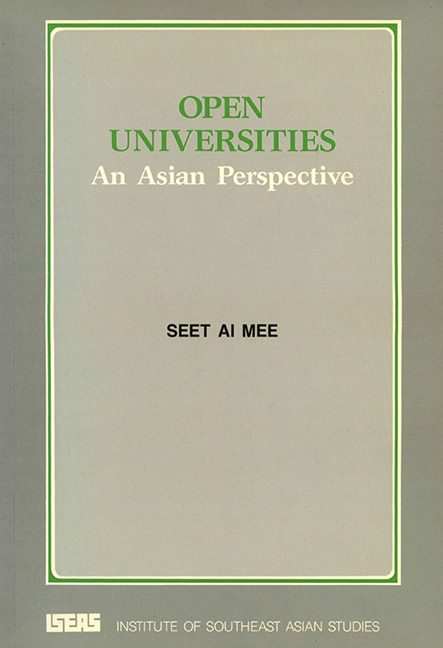Book contents
- Frontmatter
- Contents
- Acknowledgements
- I Introduction
- II Open Universities
- III The Quality of Distance Education
- IV Science and Technology Teaching
- V Continuing Professional Education
- VI Costs of Distance Education
- VII Concluding Remarks
- Notes
- Select Bibliography
- Abbreviations
- Member Institutions of the Association of Asian Open Universities
- THE AUTHOR
V - Continuing Professional Education
Published online by Cambridge University Press: 21 October 2015
- Frontmatter
- Contents
- Acknowledgements
- I Introduction
- II Open Universities
- III The Quality of Distance Education
- IV Science and Technology Teaching
- V Continuing Professional Education
- VI Costs of Distance Education
- VII Concluding Remarks
- Notes
- Select Bibliography
- Abbreviations
- Member Institutions of the Association of Asian Open Universities
- THE AUTHOR
Summary
When interviewed in 1989 on the goals or purposes of the UKOU, Lord Walter Perry, first Vice-Chancellor, had this to say:
One main purpose was to offer those who had not earned a basic degree, for whatever reason, a chance to do so.… A second goal, one that I always believed was of the utmost importance, was to offer to many the chance of updating their education with refresher courses that could be taken without having to drop out of the work force and without having to build extensive new brick and mortar campus facilities to house them.
Before the second objective could be achieved, it was necessary to achieve the first — through the building of a credible institution in the eyes of the academic world. Today, the UKOU services twice the number of its undergraduate students as “associate students”, i.e., those enrolled in the continuing professional education programme.
Change is the norm in today's world and it is often said that technology-based training is outdated within a decade, and in some areas, within five years. There is therefore a need for systematic updating and upgrading of knowledge, skills, and attitudes through continuing professional education and training. As the countries in Asia move towards greater and greater technological advancement, distance education institutions will be the ones which will provide greater impetus to this area of continuing education.
Most working adults cannot afford to stop work to update or upgrade their knowledge and skills. The economic and opportunity costs are high and many need to keep working to support themselves and their families.
The distance education mode of teaching and learning offers the mature worker the opportunity to learn while remaining economically active. Conventional universities have played, and will continue to play, important roles in continuing education. These are normally in the form of evening extra-mural classes or evening postgraduate lecture programmes.
- Type
- Chapter
- Information
- Open UniversitiesAn Asian Perspective, pp. 23 - 26Publisher: ISEAS–Yusof Ishak InstitutePrint publication year: 1992



